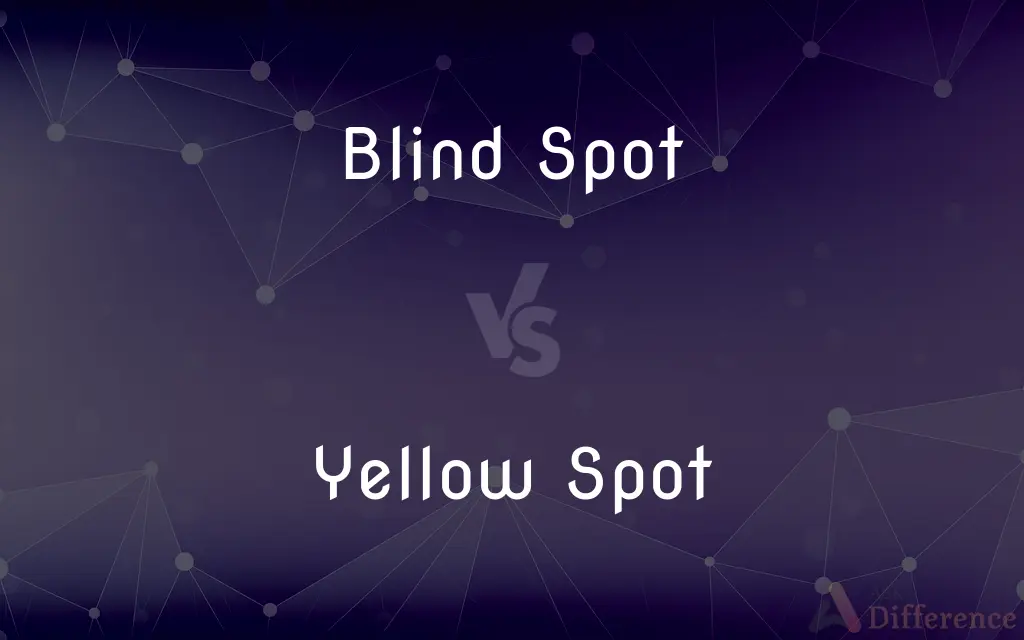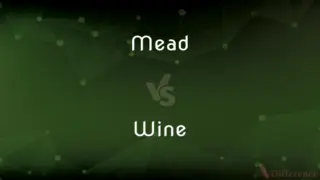Blind Spot vs. Yellow Spot — What's the Difference?
By Tayyaba Rehman & Urooj Arif — Published on September 27, 2024
Blind Spot is where the optic nerve exits the eye, creating a vision gap, while Yellow Spot is the macula, critical for sharp vision.

Difference Between Blind Spot and Yellow Spot
Table of Contents
ADVERTISEMENT
Key Differences
The Blind Spot, medically known as the optic disc, is a point in the human eye where the optic nerve fibers exit the retina, leading to an absence of photoreceptor cells. Consequently, it produces an area in the visual field that lacks image detection capability. On the other hand, the Yellow Spot, or macula lutea, is a small, central region of the retina that is rich in cones, the photoreceptors responsible for color vision and high-resolution vision.
While the Blind Spot's existence means that each eye has a small portion of the field of vision where no image is formed, the brain compensates for this lack by filling in the missing information from the other eye or based on the surrounding visual cues. Conversely, the Yellow Spot is essential for tasks requiring detailed vision, such as reading, driving, and recognizing faces, because it contains a high concentration of cones.
One significant difference between the two is their relevance to overall vision. The Blind Spot is generally unnoticed in daily life due to the brain's ability to interpolate missing information and the overlapping fields of vision from both eyes. However, the Yellow Spot is critical for central vision and color perception, making it vital for performing tasks that require fine detail.
The Blind Spot illustrates a fascinating aspect of human vision — our brains can seamlessly fill in gaps in our visual field, a phenomenon that highlights the brain's role in visual perception. In contrast, the Yellow Spot demonstrates the importance of specialized regions in the eye for performing high-acuity tasks, showcasing the complexity and efficiency of the visual system.
Despite their differences, both the Blind Spot and the Yellow Spot are integral to our understanding of visual anatomy and function. The former represents an interesting quirk of the visual system, while the latter underscores the sophistication necessary for detailed vision.
ADVERTISEMENT
Comparison Chart
Location in the Eye
Where the optic nerve exits the retina
Central region of the retina
Function
Lacks photoreceptors, creating a gap in vision
Contains high concentration of cones for sharp vision
Visibility
Not noticeable in normal vision due to brain compensation
Critical for detailed vision tasks
Importance
Illustrates the brain's ability to fill in visual gaps
Essential for central vision and color perception
Photoreceptor Type
None, due to absence of photoreceptor cells
Primarily cones, responsible for color and high-resolution vision
Compare with Definitions
Blind Spot
The optic disc's region, devoid of visual detection capability.
The Blind Spot's location is critical for understanding certain visual illusions.
Yellow Spot
A small area in the eye's retina responsible for high-resolution and color vision.
Damage to the Yellow Spot can significantly impair one's central vision.
Blind Spot
An area in vision that is not covered by the retina due to the absence of photoreceptors.
The existence of the Blind Spot is a fascinating aspect of human vision.
Yellow Spot
The part of the eye that plays a vital role in face recognition and driving.
The Yellow Spot enables us to perform tasks that require precise visual acuity.
Blind Spot
A phenomenon where certain images or stimuli cannot be seen.
The Blind Spot demonstrates the brain's ability to compensate for visual information gaps.
Yellow Spot
The macula lutea, characterized by its yellowish hue, important for detailed visual tasks.
The Yellow Spot's density of cones is why we can enjoy vivid colors and clear images.
Blind Spot
A location in the eye's retina where the optic nerve fibers exit, creating a vision gap.
The Blind Spot is an area where no image is detected, but we rarely notice it.
Yellow Spot
The central region of the retina, known for its high concentration of cones, essential for sharp vision.
The Yellow Spot is crucial for activities that require fine detail, like reading.
Blind Spot
The point in the visual field that corresponds to the lack of light-detecting photoreceptor cells on the optic disc.
Despite the Blind Spot, our brains seamlessly fill in the missing parts of our visual field.
Yellow Spot
A key area for photopic (daylight) vision, providing the ability to see fine details.
Artists rely heavily on the Yellow Spot for discerning fine color nuances.
Common Curiosities
Why is the Yellow Spot important?
The Yellow Spot is crucial for central vision, allowing us to perform tasks that require detailed vision, such as reading, driving, and recognizing faces, due to its high concentration of cones.
What is the Blind Spot?
The Blind Spot is a specific area in the human visual field that corresponds to the location on the retina where the optic nerve fibers exit, resulting in an absence of photoreceptor cells and, consequently, an area with no visual detection.
What is the Yellow Spot?
The Yellow Spot, or macula lutea, is a small, central portion of the retina, characterized by a high concentration of cone cells, which are essential for sharp, detailed vision and color perception.
Are there any similarities between the Blind Spot and Yellow Spot?
While fundamentally different in function and structure, both the Blind Spot and Yellow Spot are integral to our understanding of the human visual system and its complexity.
What happens if the Yellow Spot is damaged?
Damage to the Yellow Spot, such as that caused by macular degeneration, can lead to significant loss of central vision, affecting the ability to see fine details and colors accurately.
How does the brain compensate for the Blind Spot?
The brain compensates for the Blind Spot by using information from the other eye and the surrounding visual context to fill in the missing area, thus preventing us from noticing the gap in our vision.
Is it possible to detect your own Blind Spot?
Yes, it's possible to detect your own Blind Spot through specific tests that isolate the visual field of each eye, revealing the point at which objects disappear from view.
Why don't we notice our Blind Spot?
We don't notice our Blind Spot because the brain compensates for the missing information by filling it in with surrounding details and information from the other eye, effectively making it invisible under normal conditions.
Can the Blind Spot affect vision?
Under normal circumstances, the Blind Spot does not affect vision noticeably due to the brain's ability to fill in the missing visual information and the overlapping fields of vision from both eyes.
Can the Blind Spot ever become visible?
Under normal conditions, the Blind Spot remains invisible due to brain compensation; however, specific tests can reveal its presence by isolating vision to one eye and covering certain areas.
What role does the Yellow Spot play in reading?
The Yellow Spot plays a critical role in reading by allowing for the sharp, detailed vision necessary to distinguish letters and words clearly.
How does the Yellow Spot affect color vision?
The Yellow Spot significantly enhances color vision because it contains a high density of cones, which are the photoreceptors responsible for detecting color and fine details.
Share Your Discovery

Previous Comparison
Mead vs. Wine
Next Comparison
Bullmastiff vs. English MastiffAuthor Spotlight
Written by
Tayyaba RehmanTayyaba Rehman is a distinguished writer, currently serving as a primary contributor to askdifference.com. As a researcher in semantics and etymology, Tayyaba's passion for the complexity of languages and their distinctions has found a perfect home on the platform. Tayyaba delves into the intricacies of language, distinguishing between commonly confused words and phrases, thereby providing clarity for readers worldwide.
Co-written by
Urooj ArifUrooj is a skilled content writer at Ask Difference, known for her exceptional ability to simplify complex topics into engaging and informative content. With a passion for research and a flair for clear, concise writing, she consistently delivers articles that resonate with our diverse audience.













































